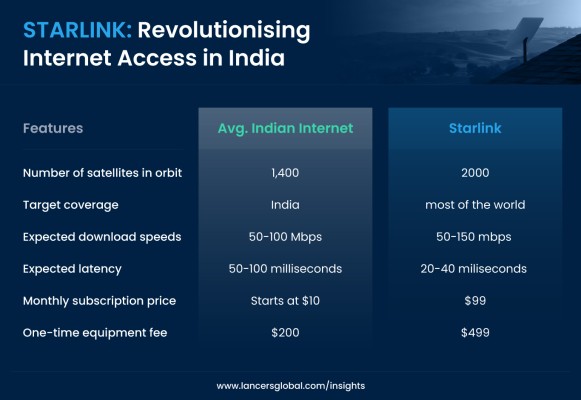Connecting the Unconnected: Starlink's Journey to Bridge India's Digital Divide
Did you know that India, with its massive population of over 1.4 billion people, still faces a digital divide, with only about 50% having internet access? Starlink, SpaceX's ambitious satellite constellation, aims to address this digital divide by venturing into the Indian market. Having already deployed 4,000 satellites and with plans for thousands more, Starlink’s journey to India promises to bring high-speed, reliable internet access to even the remotest corners of the country.
However, Starlink is not immune to challenges. It must navigate the regulatory landscape and compete with established internet providers. Millions of Indians could experience the internet for the first time, fostering economic growth in rural areas.
In this blog post, we delve into the impact Starlink satellites could have on India. We explore the challenges it faces, the potential advantages it offers, and the current state of internet access across the country. We firmly believe that Starlink possesses the technology and resources to revolutionise the Indian internet market. By bridging the digital divide, Starlink has the power to uplift communities and drive economic progress.
Witness the transformative potential of Starlink in the Indian internet market as we anticipate an exciting future for connectivity in the nation.
Starlink: The Future of Internet Access
Starlink is a satellite constellation being developed by SpaceX to provide high-speed, low-latency internet to users around the world. The constellation is currently in beta testing. It has the potential to revolutionise the internet landscape.
- In rural and remote areas, Starlink could provide much-needed internet access to people who currently lack it.
- In urban areas, it could help to improve the quality of internet access.
- And globally, Starlink could help to bridge the digital divide and provide internet access to people in developing countries.
Number of satellites launched
As of June 2023, SpaceX has launched over 4,000 Starlink satellites into orbit. The company plans to launch a total of 12,000 satellites.
Countries where Starlink is currently available
Starlink is currently available in a limited number of countries, including the United States, Canada, the United Kingdom, Germany, and Australia. The company plans to expand availability to more countries in the future.
Starlink: Revolutionising Internet Access in India

Elon Musk, the visionary behind SpaceX's satellite internet constellation Starlink, has expressed his intention to expand its presence to India following its global establishment. In June 2023, Musk had a meeting with Indian Prime Minister Narendra Modi to explore the possibility of introducing Starlink in the country. While currently accessible in select nations, Musk has expressed his ambition to extend its availability worldwide.
India, with its substantial population and increasing demand for internet connectivity, presents an appealing market for Starlink. However, a significant portion of India's rural populace still lacks reliable internet access. By venturing into the Indian market, Starlink could play a pivotal role in bridging the digital divide and delivering essential connectivity to millions of people in need.
Starlink vs. Jio: The Battle for Satellite Broadband Supremacy in India
The current clash between Starlink, Elon Musk's satellite network initiative, and Reliance Jio, owned by Mukesh Ambani, is centred around their conflicting views on the distribution of satellite broadband spectrum in India. As per reports, tensions are escalating between the two parties. Starlink argues that the Indian government should allocate licences for satellite broadband spectrum without resorting to an auction, asserting that it is a shared natural resource among companies. They contend that conducting an auction could result in limitations based on geography and increased expenses.
In contrast, Reliance holds an opposing stance, supporting the idea of conducting an auction. Ambani's company contends that foreign satellite service providers, including Starlink, have the potential to offer voice and data services, thus introducing competition to traditional telecommunications players. Reliance believes that conducting an auction is essential to ensure fair competition among all participants. It is reported that Reliance continues to advocate for the Indian government to conduct a satellite spectrum auction, rather than yielding to the demands of foreign companies.
Exploring a comparative analysis of both services would provide a clearer understanding of which option would be more beneficial and impactful for the country.
|
STARLINK |
Avg. Indian Internet |
|
Pros |
Pros |
|
High-speed Internet |
Affordable prices |
|
Low Latency |
Wide Availability |
|
Global Coverage |
Good Customer Service |
|
Not Affected by Weather |
|
|
Cons |
Cons |
|
High Cost |
Lower Speed thank Starlink |
|
Limited Availability |
Can be affected by weather |
|
Requires Clear view of the sky |
Latency can be high |
Redefining Internet Access: The Game-Changing Attributes of Starlink
Starlink's success can be attributed to a number of factors, including:
- The use of cutting-edge technology: Starlink uses a constellation of low-Earth orbit (LEO) satellites to deliver internet service. This allows for much faster speeds and lower latency than traditional satellite internet services.
- The experience of SpaceX: SpaceX is a leading aerospace company with a proven track record of success. The company has already launched over 2,000 Starlink satellites, and it plans to launch thousands more in the coming years.
- The demand for high-speed internet: The demand for high-speed internet is growing rapidly, especially in rural and underserved areas. Starlink is well-positioned to meet this demand, as it offers a reliable and affordable internet service that is available to anyone, regardless of their location.
Starlink's Challenges and the Quest for Global Internet Access
Starlink has launched its satellites in many counties by now but its establishment in India will be different. It's a developing country, the geographical and economical conditions are also different which means the challenges would be different and additional than what it faced in other countries.
Cost of the service
One challenge is the cost of the service. Starlink's current pricing is not affordable for many people in India. The company will need to find a way to reduce its costs in order to make its service more accessible.
Another challenge is the regulatory environment. The Indian government is still in the process of developing regulations for satellite internet services. This could create uncertainty for Starlink and make it difficult for the company to operate in India.
- Starlink price in India is not finalised but its service cost around the globe currently is $99 per month plus a one-time equipment fee of $499.
- Starlink's download speeds can vary depending on a number of factors, but they are typically in the range of 50-150 Mbps.
- Starlink's latency is typically in the range of 20-40 milliseconds.
- Starlink is not yet available everywhere, but SpaceX is working to expand availability in the coming years.
Regulatory hurdles
Starlink will need to obtain regulatory approval from the Indian government in order to operate in the country. This process can be lengthy and complex, as the Indian government is still developing regulations for satellite internet services.
Technical challenges
Starlink is a complex system, and there are a number of technical challenges that SpaceX will need to overcome in order to make it a viable commercial product in India. These challenges include:
- The need to adapt Starlink's technology to India's unique terrain and weather conditions.
- The need to develop a distribution network that can reach remote areas of India.
- The need to overcome the affordability barrier for Indian consumers.
Competition from other internet providers
Starlink faces competition from other satellite internet providers, as well as from terrestrial broadband providers both in India and around the world. In India, Starlink faces competition from terrestrial broadband providers, such as Jio Fiber and Airtel Fiber, and satellite internet providers, such as HughesNet and Viasat.
Around the world, Starlink faces competition from a number of other satellite internet providers, such as OneWeb and Telesat. Starlink also faces competition from terrestrial broadband providers, such as AT&T, Verizon, and Comcast.
These providers have already established themselves in the Indian market and have a significant customer base. Starlink will need to offer a competitive service in terms of price, speed, and reliability in order to succeed in India.
Environmental impact of Starlink
Starlink will require a large number of satellites to be in orbit. This could have a number of environmental impacts, including:
- Increased space debris: The satellites in Starlink's constellation could collide with other objects in space, creating space debris. This debris could pose a threat to other satellites and spacecraft.
- Increased radio interference: The satellites in Starlink's constellation could emit radio waves that could interfere with other radio signals. This could impact radio communications, such as those used by airplanes and ships.
- Increased light pollution: The satellites in Starlink's constellation could reflect sunlight, making them visible in the night sky. This could impact astronomical observations.
Potential Benefits of Starlink in India
Despite the challenges Starlink has its potential share of benefits which overwhelms the risks and challenges it comes with. Bridging the digital divide and providing access to reliable and high-speed internet access is the prime motive of Starlink but it is not limited to that. It also works in the path for:
- Enhancing resilience and redundancy: Traditional terrestrial internet infrastructure is susceptible to natural disasters, infrastructure failures, or deliberate attacks. Starlink could help to enhance resilience and redundancy in internet connectivity by providing an alternative or backup option.
- Promoting economic development: Reliable internet access is essential for economic development. It could help to promote economic development in India by providing businesses and individuals with the connectivity they need to compete in the global marketplace.
- Improving education and healthcare: High-speed internet access can improve education and healthcare in India. For example, Starlink could be used to provide online learning opportunities to students in rural areas, or to deliver telemedicine services to remote communities.
- Improving disaster relief: Starlink could be used to improve disaster relief efforts in India. It could be used to provide communication services to areas that have been affected by natural disasters, or to deliver essential supplies to remote communities.
- Ethical considerations of Starlink: Starlink could potentially be used to provide internet access to military and other government agencies. This could raise a number of ethical concerns, such as the potential for Starlink to be used to facilitate surveillance or to spread propaganda. Additionally, Starlink's use of radio waves could potentially interfere with other radio communications, such as those used by airplanes and ships. This could pose a safety hazard.
The Way Forward
Overall, Starlink is a promising new technology that has the potential to revolutionise the way we access the internet. The company has already achieved some impressive milestones, and it is well-positioned to continue to grow and succeed in the years to come. Elon Musk is working to bring Starlink to India and it also has the potential to be a game-changer for the country. It could help to make India a more connected, prosperous, and equitable country.
If Starlink is successful in India, it could have a major impact on the country. The future of Starlink in India is uncertain, but the potential benefits are clear. If the company can overcome the challenges it faces, Starlink could be a major force for good in India
Recent Posts








Add Comment
0 Comments